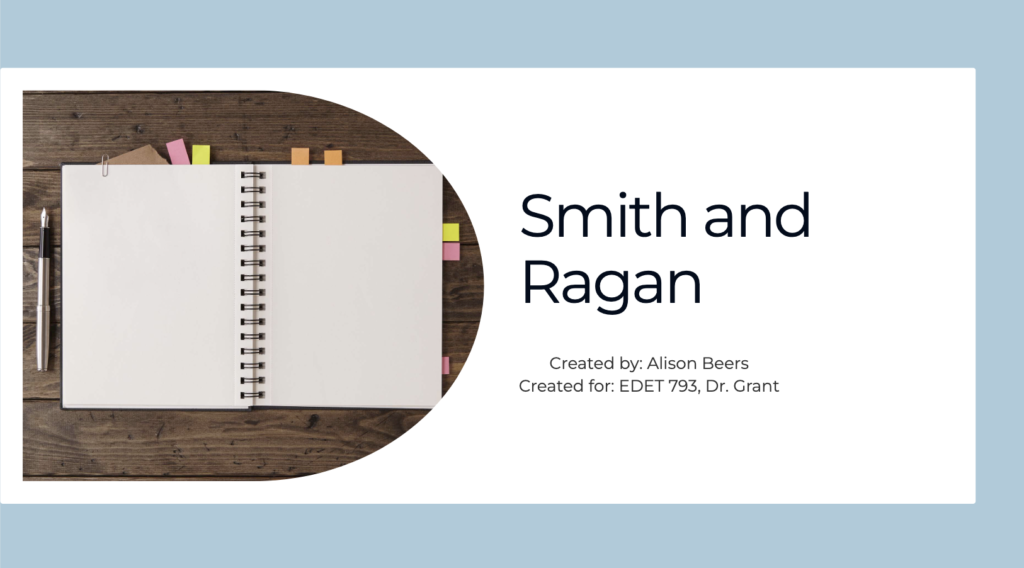AECT Standard 1
AECT Standard 1 (Content Knowledge): Candidates demonstrate the knowledge necessary to create, use, assess, and manage theoretical and practical applications of educational technologies and processes.
Read below to explore my artifacts.


Artifact 1: CANVAS e-learning course – “Breaking Down IEP’s”
Context & Conditions
The CANVAS course “Breaking Down IEP’s” was a requirement of EDET 755 Design and Evaluation of Information Access and Delivery which was completed during my third semester in the M.Ed. Learning Design and Technologies Program. This course was created in an online format through CANVAS for undergraduate/graduate students enrolled in a special education program. Prior to this course being developed, I designed an online course description, justified which online learning tools would be utilized, designed a module agendas report, and created a course syllabus adapted from the University of South Carolina.
This online course includes three learning modules. Each module includes an overview of the content, learning objectives, learning activities, and evaluation activities. This course focuses on teaching students the basics of the evaluation process, categories of disabilities that fall under an IEP/eligibility, basic components of academic and behavioral data collection/analysis, the details of each section of an IEP and how to develop an IEP. The course’s navigation menu includes the following pages: home, syllabus, modules, assignments, discussions, and grades. In addition to the three learning modules, the course also includes a getting started module and a finishing up module. On the home page of this course, a screencast is included as an overview of the course for students.
When creating this course, I applied my knowledge of the special education field from my professional experiences. My goal in creating this course was to develop a course that included information I feel would have been influential in improving my education as an undergraduate special education student.

Scope
The purpose of creating this CANVAS course was to gain experience and practice with designing and developing a full online course for college level students, through a widely used learning management system. This course could be utilized as a full unit within an undergraduate/graduate education program.
Role
This e-learning course was completed as an individual project. I acted as the sole designer of the content as well as the sole developer of the e-learning product. Throughout the creation of this e-learning module, my knowledge of instructional design processes, e-learning module development and special education content ensured a well thought out module.
Instructional Design
This e-learning course artifact relates to the learner characteristics, instructional objectives, content sequencing, instructional strategies, evaluation instruments and development of instruction stages of Morrison, Ross, and Kemp’s Model for Instructional Design (MRK). In these areas of the MRK model, the designer is required to focus on the characteristics of the learners, determine instructional procedures, determine instructional objectives, create the order of content, create assessment items for learners and develop the product (Morrison et al., 2018). This artifact could fall under all phases of the ADDIE framework. However, the phase that is most related to the ADDIE framework is the development phase. In the development phase of the ADDIE framework, the developer focuses on creation of the e-learning product (Peterson, 2003).
Related Performance Indicator
AECT Standard 1 (Content Knowledge): Candidates demonstrate the knowledge necessary to create, use, assess, and manage theoretical and practical applications of educational technologies and processes.
Indicators:
– Creating – Candidates demonstrate the ability to create instructional materials and learning environments using a variety of systems approaches.
– Using – Candidates demonstrate the ability to select and use technological resources and processes to support student learning and to enhance their pedagogy.
-Assessing/Evaluating – Candidates demonstrate the ability to assess and evaluate the effective integration of appropriate technologies and instructional materials.
-Managing – Candidates demonstrate the ability to effectively manage people, processes, physical infrastructures, and financial resources to achieve predetermined goals.
-Ethics – Candidates demonstrate the contemporary professional ethics of the field as defined and developed by the Association for Educational Communications and Technology.
Reflection
During the creation of the “Breaking Down IEP’s” CANVAS course, I learned how to design and develop a virtual course for college level students. In addition, I learned how to navigate and appropriately use an unfamiliar development tool, CANVAS. During the process of developing this course, I utilized the design documentation and planning documents created to build the course.
The development of this course was the first time I navigated building a course through CANVAS. The platform easily allowed for alignment with the design documentation report information. The features and abilities of the platform made for an easy transfer of learning material and evaluation activities. Specifically, the navigation of the platform allowed for an extremely organized course which allows learners to easily access needed materials. When designing this course, I chose a topic I am passionate about which assisted in the process of choosing learning content and evaluation items that were appropriate and useful for students.
At the time this course was designed and developed, knowledge and skills in the area of digital accessibility were not yet explored within the program. If I were to design and develop this course again, I would ensure that all pictures/images included alt text. In addition, I would ensure that all headings/content are inputted correctly to create an accessible course for all learners. These topics were not taken into consideration when building this virtual course.
Throughout the M.Ed. Learning Design and Technologies program, I have learned the importance of choosing a platform that is conducive of the design documentation plan. Throughout the program, I have attempted to explore a different platform for each e-learning module created to gain experience with various platforms/software. Each platform I have utilized has pros and cons. The platform chosen needs to match the design in order to develop a successful product that adequately represents the design process. The CANVAS platform perfectly matched the design for this course.

Artifact 2: Adobe Captivate – e-learning module “Smith and Ragan”

Context & Conditions
The e-learning module “Smith and Ragan” was a requirement of EDET 793 Advanced Instructional Design and Development which was completed during my fifth semester in the M.Ed. Learning Design and Technologies Program. In order to create this e-learning module, a thorough design documentation report was composed.
The design documentation report included the following: a goal analysis, a learner analysis, a contextual analysis, a task analysis, performance-based objectives, assessment items, an instructional strategy plan, a treatment report, planning documents, a storyboard, and additional resources. The e-learning module was designed for graduate level instructional design students with the goal for students to explore various instructional design models. For my e-learning module, I chose to educate students on the Smith and Ragan instructional design model. The course was developed using the Adobe Captivate platform and the initial module was revised following a formative evaluation. The artifact shown is the final module displaying revisions made due to the findings of the evaluation.
The e-learning module is based on three goals that were set for learners. For all goals, learning material, practice items and assessment items were designed and created. The learning material was created based on the analyses and research conducted during the design process. For this module it was important to make instructional decisions regarding the material and assessments specifically based on the learner and contextual analyses. This is due to preparing this module for adult learners and to ensure engagement and learner success. The learning goals and objectives written were the blueprint for learning material and proper evaluation of learner success and attitudes.

Scope
The purpose of the Smith and Ragan artifact was to demonstrate expert level knowledge and abilities in the design and development of an e-learning module. This e-learning module would not be presented as an entire instructional unit. However, it could be used within an instructional unit regarding various instructional design models.
Role
This e-learning module was completed as an individual project. I acted as the sole designer of the content as well as the sole developer of the e-learning product. Throughout the creation of this e-learning module, my knowledge of instructional design processes and e-learning module development best practices are apparent and ensured a well thought out module.
Instructional Design
This e-learning module artifact relates to the learner characteristics, task analysis, instructional objectives, content sequencing, instructional strategies, evaluation instruments and development of instruction stages of Morrison, Ross, and Kemp’s Model for Instructional Design (MRK). In these areas of the MRK model, the designer is required to analysis the characteristics of the individuals, determine instructional procedures, determine instructional objectives, create the order of content, create assessment items for learners and develop the product (Morrison et al., 2018). This artifact could fall under all phases of the ADDIE framework. However, the phase that is most related to the ADDIE framework is the development phase. In the development phase of the ADDIE framework, the developer focuses on two main areas creating the product, and assessing the product (Peterson, 2003).
Related Performance Indicator
AECT Standard 1 (Content Knowledge): Candidates demonstrate the knowledge necessary to create, use, assess, and manage theoretical and practical applications of educational technologies and processes.
Indicators:
– Creating – Candidates demonstrate the ability to create instructional materials and learning environments using a variety of systems approaches.
-Using – Candidates demonstrate the ability to select and use technological resources and processes to support student learning and to enhance their pedagogy.
-Assessing/Evaluating – Candidates demonstrate the ability to assess and evaluate the effective integration of appropriate technologies and instructional materials.
-Managing – Candidates demonstrate the ability to effectively manage people, processes, physical infrastructures, and financial resources to achieve predetermined goals.
-Ethics – Candidates demonstrate the contemporary professional ethics of the field as defined and developed by the Association for Educational Communications and Technology.
Reflection
During the creation of the Smith and Ragan e-learning module, I continued to learn how to develop virtual instructional products. In addition, I learned how to navigate and appropriately use an unfamiliar development tool, Adobe Captivate. During the process of developing this e-learning product there were many challenges I faced as a developer.
The design documentation for this e-learning product was thorough and well thought out to include all necessary information, tasks, practice items and assessments. However, I faced the challenge of utilizing a platform that was not conducive to all components of the design documentation report. The platform’s structure and abilities were limiting which led to changes made to the product during the development process. For example, when building the practice and assessment items for the module, not all items that were designed were able to be developed within the platform. This was due to the assessment item choices the platform provides. Due to this, the assessment items needed to be altered to ensure production of the assessment without compromising the item assessing the objective. In addition, the platform does not allow for a unstructured creative space for the developer. It was a challenge to appropriately chunk instructional material while still creating an engaging design/module for the learner. If this module were to be produced again, as a developer, I would choose to use a different platform with further capabilities and creative allowances.
Throughout the M.Ed. Learning Design and Technologies program, I have learned the importance of choosing a platform that is conducive of the design documentation plan. Throughout the program, I have attempted to explore a different platform for each e-learning module created to gain experience with various platforms/software. Each platform I have utilized has pros and cons. The platform chosen needs to match the design in order to develop a successful product that adequately represents the design process.